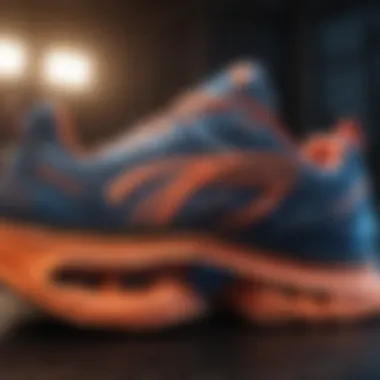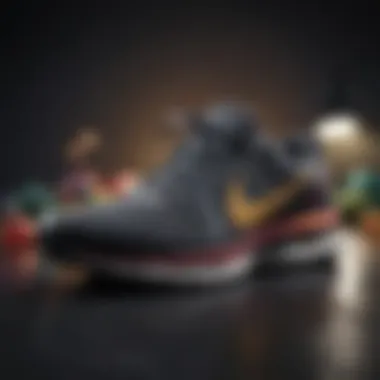The Evolution of Stylish Running Shoes: Fashion Meets Function


Intro
The realm of running shoes has evolved dramatically over the past few decades. From mere sports gear to a key component of personal style, running shoes have successfully merged functionality with aesthetic appeal. This shift mirrors broader trends in consumer preferences, where consumers prioritize not only performance but also how footwear aligns with their individual style and identity.
Stylish running shoes are more than just tools for exercise; they have become a statement of lifestyle. This article delves into the nuances of this evolution, focusing on how fashion trends, innovative designs, consumer behavior, and sustainability influence modern running shoes.
Fashion Trends
The integration of fashion and athletic wear is not a mere coincidence. The convergence reflects a deeper connection between personal expression and footwear.
Seasonal Styles
With each season, we see fresh trends emerging. During spring, lighter materials and pastel colors dominate the market, while autumn often brings earthy tones and more robust designs. This seasonal variation plays a crucial role in attracting consumers who wish to stay stylish while remaining practical.
Influencer Inspirations
Influencers and celebrities significantly impact what is considered fashionable. Their choices endorse specific brands and styles, leading to spikes in demand. For instance, when notable figures sport a particular model, that running shoe can quickly gain popularity, especially among younger demographics. This phenomenon illustrates the power of visual influence in shaping consumer perspectives.
"The lines between functional design and style are increasingly blurred in today’s market, impacting consumer choices."
Innovative Design
The aesthetics of running shoes are not just skin-deep; innovative designs play a substantial role in attracting consumers. Materials such as breathable mesh and lightweight synthetic fabrics elevate both performance and look. Moreover, brands are developing unique colors and patterns that offer myriad choices for personal expression.
Modern designs also integrate technology. Features such as cushioning systems and arch support are tailored for specific foot types, marrying comfort with visual appeal. This approach ensures that while the shoe looks good, it also performs well.
Consumer Preferences
Understanding what consumers desire can help brands craft better products. Surveys show that individuals are increasingly looking for shoes that provide both comfort and a stylish appearance. Particular attention is given to how footwear fits into larger wardrobe choices rather than simply serving as athletic gear.
Sustainability Considerations
Another pivotal aspect has emerged in consumer decision-making: sustainability. Brands like Nike and Adidas have initiated programs focusing on eco-friendly materials and manufacturing processes. Shoppers today are more inclined to purchase products that reflect their values, making sustainability a central consideration in the evolution of running shoes.
Preamble to Running Shoes
The realm of running shoes has evolved significantly over the years, representing an intersection of functionality and style. This article explores the various elements that underline the importance of running shoes not only as performance enhancers but also as fashion statements. The radical transformations in design and consumer preferences necessitate a comprehensive understanding of how running shoes serve dual purposes.
Definition and Purpose
Running shoes are specially designed footwear aimed at providing comfort, support, and protection to runners. Their primary purpose is to enhance the running experience, minimizing the risk of injury while optimizing performance. Key elements include cushioning, stability, and traction. Depending on the runner's style, foot type, and terrain, the appropriate running shoe may vary.
The modern running shoe transcends basic utility. Many users view them as an integral part of their personal style. As a result, running shoes often reflect current fashion trends, emphasizing aesthetics alongside performance features. Thus, the definition of running shoes has expanded to encompass both their physical attributes and their role in personal expression.
Historical Context
The history of running shoes can be traced back to the early 20th century. Initially, they were designed for athletic performance with minimal focus on aesthetics. In the 1970s, the running boom popularized running as a recreational activity, leading to increased demand for specialized footwear. Companies such as Nike and Adidas began to innovate, integrating technology to improve performance.
With advances in materials and design in the 1980s and 1990s, running shoes became more diverse. This era saw the emergence of colorful designs and branding, as running shoes transitioned into a status symbol rather than solely performance gear. Today, brands are engaging in a constant evolution of styles, merging fashion with function, which has reshaped the industry.
The historical development of running shoes highlights their journey from purely functional footwear to a complex blend of performance, aesthetics, and personal branding. This evolution reflects broader societal changes towards individualism and self-expression, making running shoes a critical study in both the sports and fashion industries.
Design Elements of Stylish Running Shoes


The design elements of stylish running shoes play a crucial role in their appeal and functionality. Running shoes are no longer just basic sports footwear; they have become an essential component of modern fashion and personal expression. Designers are tasked with the challenge of balancing aesthetics and performance. This balance not only enhances the user experience but also influences purchasing decisions for a broad audience, especially women of all ages.
Aesthetic Considerations
Aesthetic considerations are fundamental in the design of stylish running shoes. The visual appeal of footwear can attract potential buyers and dictate trends in the market. Color choices, patterns, and overall silhouettes are essential elements in making a statement. Recent trends show a clear preference for vibrant color palettes and bold patterns. These options allow consumers to express their individuality while maintaining comfort during physical activity.
Additionally, collaborations with artists and designers have led to unique offerings. Iconic brands like Nike, Adidas, and Puma often launch limited-edition styles that promote exclusivity and creativity. Customers often seek shoes that not only serve a function but also align with their personal brand image.
"The intersection of art and function in running shoe design pulls consumers in, making them feel connected to the product on multiple levels."
It’s important for brands to keep an eye on cultural influences as styles evolve. The emergence of streetwear and athleisure has pushed design boundaries. Consumers now expect running shoes to seamlessly transition from workouts to casual outings. Thus, ensuring that aesthetic qualities are at the forefront of the design process is essential.
Functional Aspects
Functional aspects of running shoes are as vital as their aesthetic considerations. Ultimately, the primary purpose of running shoes is to provide support and comfort during physical activity. The integration of advanced technology is a significant factor here. Features such as responsive cushioning, lightweight materials, and moisture-wicking fabrics enhance performance. These elements ensure that the shoes cannot only withstand rigorous use but also compete in a fashion-conscious market.
Moreover, fit and support are crucial for preventing injuries among runners. A well-designed running shoe takes into account the anatomy of the foot, offering arch support and stability. This approach aids in the prevention of common issues such as plantar fasciitis and ankle sprains.
Sustainability is another functional consideration gaining traction. Brands are increasingly focusing on eco-friendly materials and production methods. For example, Reebok has introduced shoes made from recycled plastic waste. As women increasingly prioritize sustainability in their purchasing decisions, functional designs that consider the environment can also enhance a brand’s image.
By recognizing the significance of both aesthetics and function, manufacturers can meet the evolving expectations of consumers, thereby solidifying their place in an ever-competitive market.
Key Features of Attractive Running Shoes
The importance of key features in attractive running shoes extends beyond mere aesthetics. Stylish running shoes have become essential not only for their practical purposes but also for their role in personal expression and identity. As the market continues to evolve, it is critical to address the elements that make running shoes appealing to consumers, particularly to women of all ages.
Color Schemes and Patterns
Color schemes and patterns play a vital role in attracting customers to running shoes. Women often look for shoes that match their personal style, wardrobe, or the image they wish to portray. Bright colors and unique patterns can make a statement, while neutral tones may appeal to those seeking versatility.
- Trendy Palettes: Seasonal trends can dictate popular colors. Shades like pastel pinks or deep greens can enhance appeal.
- Personalization: Many brands allow customization, making it possible for individuals to choose their color combinations. This adds a personal touch, enhancing emotional attachment to the footwear.
- Patterns: From geometric shapes to floral designs, patterns create an eye-catching appeal. They can reflect the wearer's personality or lifestyle.
Overall, color and pattern selection transcends mere visual appeal; it influences the buying decision significantly.
Material Choices
The choice of materials in running shoes significantly affects both function and appeal. Quality materials contribute to durability, comfort, and, ultimately, consumer satisfaction.
- Breathability: Fabrics like mesh offer ventilation, keeping feet cool during activities.
- Lightweight Materials: Innovations in lightweight materials improve performance, making running less strenuous.
- Aesthetics: The texture can add depth and richness to the shoe's appearance, such as suede or metallic finishes.
Choosing the correct materials provides not just performance advantages but also enhances visual harmony, merging style with practicality.
Sustainable Materials
Sustainability has become a pressing concern in the footwear industry. As consumers grow more conscious of environmental impact, the demand for sustainable materials is rising.
- Eco-Friendly Options: Many brands now utilize recycled plastics and organic materials in their running shoes. This aligns the shoes with environmentally responsible choices.
- Ethical Sourcing: The consumers today prefer brands that practice ethical sourcing, which can enhance a brand's image and consumer trust.
- Performance and Style: Sustainable materials often meet high standards for performance while still providing aesthetic appeal.
Using sustainable materials not only helps the planet but also resonates with consumers who value ethical practices, creating a win-win scenario for both brand and buyer.
"The evolution of running shoes is not just about function, but about integrating style and sustainability in a meaningful way."
Impact of Running Shoes on Personal Style
The relationship between running shoes and personal style has evolved significantly. Initially designed solely for sports, these shoes have transitioned into a fixture of everyday fashion. The impact of running shoes on personal style cannot be overstated; they serve as a vital element in self-expression and identity. With heightened awareness around athletic wear, stylish running shoes now contribute to overall aesthetics, making them prevalent in wardrobes beyond just fitness enthusiasts.


Fashion Statements
Stylish running shoes are often worn as fashion statements that reflect individual personality or lifestyle. They allow wearers to merge comfort with trendiness. Different designs can convey different messages—bold colors may symbolize confidence, while minimalist styles may denote sophistication. As fashion collaborations increase, brands like Nike and Adidas have partnered with designers to create unique collections that enhance their appeal as fashion items.
Moreover, various sneaker collections have become symbolically valuable. Limited-edition releases attract sneakerheads and collectors alike, creating a subculture that revolves around stylish running shoes. These collaborations not only elevate the aesthetic value of the shoes but also fuel discussions about cultural status and exclusivity.
Cultural Influence
Culturally, running shoes have transcended their athletic origins to become a significant part of popular culture. They frequently feature in music videos and social media, influencing how young people perceive fashion. Artists and celebrities often showcase their favorite sneakers, prompting fans to emulate their style choices. This phenomenon illustrates a shift in what is considered stylish; athletes and entertainers alike have established running shoes as style staples in the casual wear segment.
Furthermore, different communities may adopt specific styles of running shoes as markers of belonging or identity. For instance, streetwear trends heavily influence urban fashion, integrating running shoes into everyday attire. This cultural embrace of running shoes showcases their role as versatile fashion pieces that can fit various contexts and occasions.
"Running shoes have become not only functional gear but also a canvas for creativity, showcasing art and culture through the lens of footwear."
In summary, stylish running shoes have evolved into essential components of personal style. They serve dual purposes, fulfilling athletic needs while also allowing for self-expression through fashion. As trends continue to change, the interplay between function and style will further shape the landscape of running shoes.
Psychological Factors in Shoe Selection
Understanding the psychological factors in shoe selection is essential to grasp the significance of stylish running shoes. These factors influence consumer behavior, determining how individuals perceive and choose footwear. Running shoes are not only functional; they also serve as a medium of self-expression and confidence, deeply intertwined with personal identity and social status.
Self-Expression Through Footwear
Self-expression is one of the most pivotal aspects when it comes to footwear. Stylish running shoes act as a canvas for personal taste. Fashionable designs, unique patterns, and vibrant colors allow wearers to communicate their personality. Individual choices in footwear reflect broader lifestyle preferences and cultural affiliations. Modern consumers seek running shoes that resonate with their identity. This drives brands to innovate continually, offering a diverse range of styles that cater to distinct tastes.
Consumers often curate their shoe selection based on current trends or iconic styles. Limited edition releases, collaborations with designers, or celebrity endorsements also create an aspiration to own unique pairs. Key elements such as branding play a substantial role. For example, a pair of Nike Air Max might represent not only a quality product but also a symbol of status and trendiness. Therefore, how consumers choose their running shoes ties back to their desire to project their true selves into the world.
Confidence and Comfort
Confidence linked to footwear cannot be understated. The right pair of stylish running shoes can enhance not just physical performance but also mental state. When individuals wear shoes that look good and feel comfortable, they tend to carry themselves differently. This connection is particularly pronounced in running. The psychological boost that comes from wearing attractive shoes can improve overall motivation and performance.
Comfort also remains a significant consideration in shoe selection. No one wants to sacrifice comfort for style. The psychological tensions between aesthetic appeal and ergonomics come into play. Innovations in technology have made it possible to have both, where stylish designs incorporate supportive materials that enhance comfort. The right fit, cushioning, and support can reduce fatigue and allow runners to engage fully in their activities.
When shoes provide physical comfort, they can also alleviate performance anxiety. This effect can enhance a runner's confidence, leading to better performance, as they feel free to push their limits. The duality of style and comfort in running shoes reflects a growing understanding of the holistic experience they provide.
"Shoe choices resonate deeply with one's self-image and aspirations, showcasing the essential role they play in personal and social contexts."
Popular Brands in Stylish Running Shoes
The significance of popular brands in stylish running shoes cannot be overstated. These brands not only shape trends but also drive the evolution of running footwear by integrating cutting-edge technology with contemporary design. They play a vital role in constructing public perception about what makes a running shoe appealing. When consumers choose footwear, they often look to established names that they believe offer both quality and style. This blending of image and substance enhances the overall attractiveness of running shoes.
In contemporary fashion, running shoes are not just about performance. They have transformed into a mode of self-expression where individual identity is communicated through footwear choices. Thus, brands become part of this narrative, influencing styles and preferences across various demographics.
Brand Histories
The history of a brand contributes significantly to its identity. Many popular brands, such as Nike, Adidas, and Asics, have roots dating back several decades, with each brand contributing unique perspectives to the running shoe market. For instance, Nike emerged in the 1960s, focusing on performance innovation and later expanding into lifestyle markets. Adidas, with its iconic three stripes, built a reputation equally strong in sports and fashion.
Asics, known for its commitment to research and technology, emphasizes biomechanics in its design philosophy, which resonates well with serious runners. Understanding these histories provides insight into how brands have evolved.
- Nike
- Adidas
- Asics
- Founded in 1964, it pioneered athletic footwear technology.
- The ‘Just Do It’ mantra merged performance with lifestyle branding.
- Established in the 1940s, it became a symbol of athletic style.
- Collaborations with high-profile designers have solidified its fashion status.
- Launched in 1949, known for its scientific approach to running.
- Mixing technology with comfort has made it a favorite for athletes.


Signature Designs
Signature designs from popular brands often reflect current fashion trends and consumer preferences. Brands like Nike and Adidas have successfully created signature models, such as the Nike Air Max and Adidas Ultraboost, which are recognized globally. These shoes combine aesthetics with comfort, providing a dual appeal for those who want performance while also looking stylish.
Some elements of signature designs include:
- Colorways: Bright and bold color combinations attract a younger audience.
- Silhouette: Unique shapes that stand out in a crowded market.
- Innovative Materials: Use of lightweight yet durable materials for both performance and look.
"The appeal of stylish running shoes lies in their ability to combine comfort with contemporary design, making them suitable for a variety of settings, from the gym to casual outings."
Brands like New Balance and Puma also leverage signature designs to cater to niche markets, including sustainable options or limited-edition collaborations. This strategy attracts consumers looking for exclusivity or eco-friendliness in their choices. Understanding brand histories and signature designs is crucial for informed consumers who wish to navigate the ever-changing landscape of stylish running shoes in a meaningful way.
Consumer Preferences and Trends
Understanding consumer preferences is essential in the realm of stylish running shoes. The intersection of style and utility has become increasingly important to buyers. Today’s consumers demand not only performance from their footwear but also a representation of their identity and values. This is evident in the choices made by women of all ages, who seek running shoes that reflect their personal style while supporting their active lifestyles.
Market Research Insights
Market research indicates a clear shift in consumer buying behavior towards stylish running shoes. Reports from leading market research firms show that aesthetics often influence purchase decisions as much as functionality. A focus group conducted with diverse age groups revealed that 75% prioritize design, with many citing color and silhouette as deciding factors.
Furthermore, sales data demonstrates a growing trend toward brands that innovate both in aesthetic appeal and technological advancements. For instance, Nike and Adidas have capitalized on this by introducing bold colors and unique patterns. Their designs do not just meet performance metrics but also integrate fashion sensibilities, appealing to a broader audience within the running and lifestyle sectors.
Influence of Social Media
Social media plays a pivotal role in shaping trends in running shoes. Platforms like Instagram and Pinterest serve as visual showcases for new designs and collaborations, allowing brands to reach wider audiences quickly. According to research, about 58% of consumers discover new styles through social media. This is especially true for younger demographics, including millennials and Gen Z, who often rely on influencer endorsements to make purchasing decisions.
The immediacy of social media also allows for instantaneous feedback. Consumers often share their opinions and experiences, which can sway the purchasing decisions of their peers. Brands that engage with customers online tend to build a loyal following, leveraging comment sections and direct messages to foster a sense of community. This connection not only drives sales but also encourages brands to adapt to audience preferences in real time.
"Fashion is about more than just looks; it’s deeply connected to identity and expression in today’s world."
The Future of Stylish Running Shoes
Innovations in Design and Technology
The intersection of design and technological advancements marks a pivotal moment in the footwear industry. Companies are embracing new materials and production techniques that enhance both performance and style. One notable advancement is the use of 3D printing technology. Brands now create personalized fits, reducing waste and improving comfort. Customization can also extend to colors and patterns, allowing consumers to express their individuality more than ever before.
Moreover, smart technology integration is becoming common. For instance, shoes equipped with sensors can monitor performance metrics. This data helps athletes analyze their strides and adjust techniques, effectively merging fashion with functionality. Additionally, advancements like knit uppers provide breathability and support, moving towards a more adaptable fit that complements various activities.
Another crucial aspect is cushioning technology. Modern innovations in responsive cushioning materials respond to each stride. These advancements not only elevate comfort but also ensure that the footwear remains lightweight, which is critical for performance-oriented running shoes.
Sustainability and Ethical Practices
Sustainability is a pressing concern for consumers today. Many are increasingly inclined to choose products that reflect their values regarding environmental impact. Stylish running shoes fit into this trend through the adoption of sustainable practices. Brands are exploring eco-friendly materials, such as recycled plastics and organic cotton, to reduce their carbon footprints.
Ethical sourcing is another component. Consumers are aware of where their products come from and the labor practices involved in production. As a result, many companies commit to transparency in their supply chains, ensuring fair labor conditions. This approach not only builds trust with consumers but also elevates the brand's reputation.
“The future of stylish running shoes hinges on marrying performance with sustainability, capturing the essence of what modern consumers desire.”
Additionally, innovations in manufacturing processes aim at reducing resource consumption. Brands investing in more efficient production technologies seek to minimize waste while maintaining quality. This commitment to eco-consciousness resonates with consumers, influencing their purchasing decisions and fostering loyalty.
Epilogue
Summary of Insights
From our exploration, we learned that stylish running shoes are not merely tools for physical activity; they serve as significant contributors to personal expression. The interplay of aesthetics, technology, and cultural influences have shaped contemporary shoe design. Moreover, as consumer preferences lean towards sustainability and ethical practices, brands must adapt to meet these expectations. Stylish running shoes now reflect not just a trend but an evolving narrative that resonates with a wide audience. Research shows that today’s consumers are increasingly concerned about sustainable materials without compromising style or functionality. This growing awareness presents challenges and opportunities for manufacturers in the footwear market.
Final Thoughts on Style and Functionality
"Stylish running shoes embody the essence of modern footwear—function matched with fashion, reflecting our society’s growing desire for both performance and personal expression."
By examining these dimensions, we can appreciate the intricate dynamics at play in the world of running shoes, which underscores their prominence not just in sports but as a significant element of everyday fashion.



